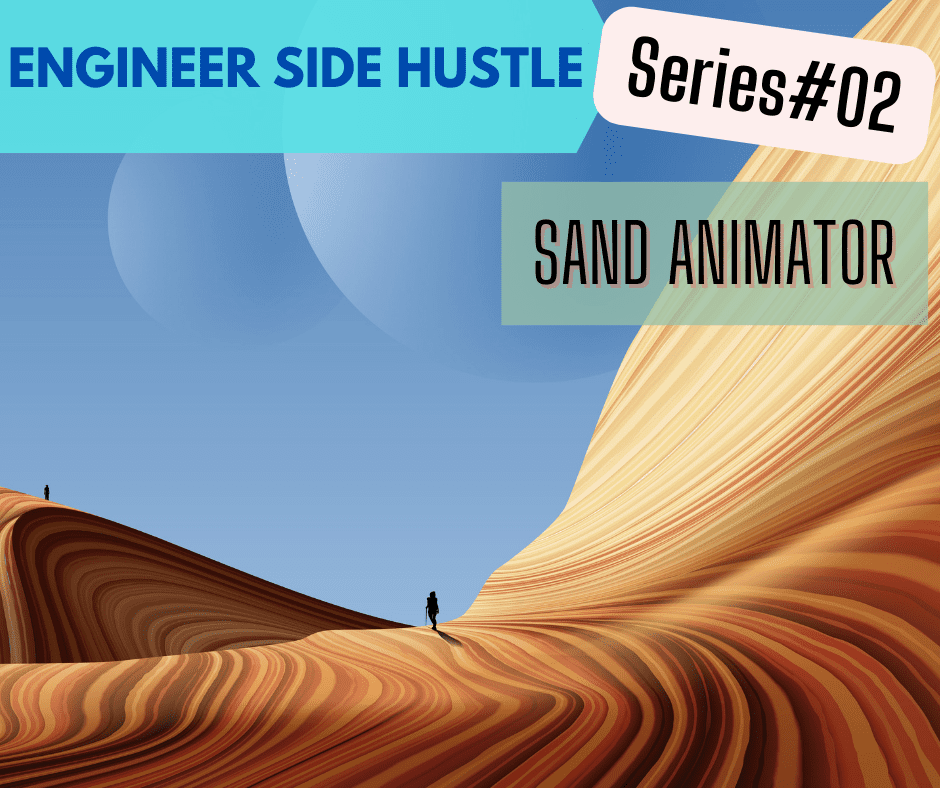If you’re looking for a creative and fun way to make some extra money, consider becoming a sand animator! This is a great way to get started in the animation industry without having to invest in expensive equipment or software. And best of all, you can do it as a freelancer or side hustle, so it’s a great way to make some extra cash on the side.
Engineers can be sand animator as a freelancer or side hustle. With some basic engineering skills, you can create beautiful sand animations. This can be a fun way to make money on the side, or even as a full-time freelancer.
Sand animation is a type of art that involves using sand to create images. The sand is usually placed on a lighted surface, and the artist uses their hands or other tools to create the desired image.
There are several different types of sand animation, including hand-drawn, digital, and stop-motion. Hand-drawn sand animation is the most traditional form of the art, and involves the artist drawing the desired image in the sand. Digital sand animation involves the use of computer-generated images, and stop-motion sand animation involves the use of photographs or other still images that are then animated.
Sand animation can be used to create a wide variety of images, from simple patterns to complex scenes. The art form is often used for storytelling and can be used to create both abstract and representational images.
Sand Animators: Who They Are and What They Do
Sand animators are artists who use sand to create images and animations. The sand is placed on a light box, which is then illuminated from below. The artist then uses various tools to manipulate the sand into different shapes and designs.
There are two main types of sand animation: freehand and pre-drawn. Freehand sand animation is where the artist creates the design entirely from scratch, using their hands and various tools. Pre-drawn sand animation is where the artist starts with a pre-drawn design, which they then trace over with the sand.
Both types of sand animation require a great deal of skill and practice. The artist must be able to control the sand and create the desired shapes and designs.
Sand animation is a relatively new art form, but it is slowly gaining popularity. It is a unique and fascinating way to create art, and it is sure to continue to grow in popularity in the years to come.
What is Sand Animation?
Sand animation, also known as sand art, is a type of performance art that uses sand to create images. Sand animation is a form of storytelling that has been used for centuries. It is often used to tell stories from different cultures and to teach children about history and different religions.
Sand animation is a type of performance art that uses sand to create images. Sand animation is a form of storytelling that has been used for centuries. It is often used to tell stories from different cultures and to teach children about history and different religions.
There are two types of sand animation: freehand and frame-by-frame. Freehand sand animation is when the artist draws directly in the sand without any preconceived idea of what the final image will look like. Frame-by-frame sand animation is when the artist creates an image one frame at a time, similar to stop-motion animation.
Sand animation can be performed with any type of sand, but most artists prefer to use sand that is brightly colored. The sand is often placed on a light box, which makes it easier to see the images that are being created.
Most sand animators use their hands to create the images, but some use tools such as brushes or sticks. The sand is moved around on the light box to create the desired image. Once the image is complete, it is usually photographed or videotaped so that it can be shared with others.
How Does Sand Art Work?
Sand animation, also known as sand art, is a type of performance art in which artists create images by moving colored sand around on a lighted surface. It can be a form of entertainment, therapy, or even meditation.
There are different types of sand animation, but the most common is probably animated gifs. In this type of animation, artists create images by moving sand around on a lighted surface. The sand is usually illuminated from below, so that the images appear to be floating in the air.
The sand is moved around with various tools, such as brushes, combs, and even fingers. The sand is usually colored, so that the images are more visible. Sometimes, the sand is also used to create words or other shapes.
Sand animation is a relatively new art form, but it is rapidly gaining popularity. It is often used in advertising, as well as in movies and television shows.
Types of Sand Animation Art
Sand animation, also known as sand art, is a type of performance art in which artists create images by moving colored sand around on a lighted surface. It can be a live performance or pre-recorded video.
There are two types of sand animation: freehand and frame-by-frame. Freehand sand animation is where the artist draws directly on the sand without any preconceived idea of what the final image will look like. Frame-by-frame sand animation is where the artist first creates an image on paper or another surface, and then recreates it frame-by-frame in the sand.
Most sand animation artists use their hands to move the sand around, but some use tools such as brushes, combs, and even chopsticks. The sand is usually illuminated from below, which makes the images appear to glow.
Sand animation is a relatively new art form, but it has already gained popularity around the world. It is often used for live performances, as well as for music videos, commercials, and short films.
FREQUENTLY ASKED QUESTIONS
who started sand animation?
Sand animation is a type of stop-motion animation. In sand animation, the artist creates a scene or story by moving sand around on a flat surface.
The history of sand animation is not well documented, but it is believed that the first person to use sand animation was a performer named Joseph Plateau. Plateau is credited with creating the first stop motion animation in 1832. He used a series of different frames to create a short film called “The Flute Player”.
Since Plateau’s time, sand animation has been used by a number of different artists. In the 1940s, Russian animator Yuri Norstein used sand animation to create a number of short films. In the 1970s, American artist Tony Hillerman used sand animation to create a number of short films and commercials.
Today, sand animation is still used by a number of different artists. Some of the most well-known sand animators include Bill Plympton, Janie Geiser, and PES.
What is sand art called?
There is no definitive answer to this question as the term “sand art” can be used to refer to a wide variety of different art forms that use sand as a medium. However, some of the most common types of sand art include sand painting, sand sculpture, and sand animation.
Sand painting is the oldest and most commonly known type of sand art. It involves creating a picture or design by sprinkling or pouring sand onto a flat surface. The sand is then manipulated into the desired shape and left to dry.
Sand sculpture is a more recent form of sand art that originated in the 1960s. It involves creating three-dimensional sculptures from sand, often using tools such as tweezers and toothpicks to create fine details.
Sand animation is a relatively new form of sand art that uses a special type of sand that can be animated by blowing on it. This type of sand is often used to create short animated films.
How can i learn sand animation skills?
If you’re interested in learning sand animation skills, there are a few things you need to keep in mind. First, it’s important to have some basic drawing skills. You don’t need to be an expert, but you should be able to draw simple shapes and lines. Next, you’ll need to learn how to control the sand. This involves using the right amount of pressure and moving your hand in the right way. It can take some practice to get the hang of it, but it’s worth it! Finally, you’ll need to find a good source of inspiration. Watch other sand animators and try to figure out what makes their animations so interesting. With a little practice, you’ll be able to create your own amazing sand animations!
How can I be a sand animator?
Sand animation is an animation technique used to create the illusion of movement by manipulating sand. It has been used in a number of films, including Peter and the Wolf (1946), The Thief of Baghdad (1940), and The Sorcerer’s Apprentice (1948).
To be a sand animator, you will need some basic skills, including drawing and animation. You will also need to be able to work well with sand, which can be a messy medium.
The first step is to create a storyboard. This is a series of sketches that show the sequence of the animation. Once you have the storyboard complete, you can start creating the animation.
You will need a flat surface to work on, such as a table or a countertop. You will also need a container to hold the sand, such as a tray or a bowl.
You can start by drawing the outline of the characters or objects you want to animate on the surface of the sand. Then, you can start adding the details. Use a stick or a pencil to move the sand around and create the desired effect.
Keep in mind that sand animation is a very slow process, so you will need to be patient. It can take hours, or even days, to create a short animation.
how much does sand animator earn?
Sand animators are artists who use sand to create animated scenes. They may use sand to create individual frames of a movie, or to create entire scenes. Sand animators typically work for studios or production companies, creating animations for commercials, movies, or television.
The average salary for a sand animator is around $50,000 per year. However, this can vary depending on experience, skills, and the company or studio you work for. Some sand animators may earn more, while others may earn less.
If you are interested in becoming a sand animator, it is important to have a strong artistic background. You should also be skilled in animation or CGI software. It is also helpful to have experience in sculpting or other forms of art.
If you are looking for a career in animation, sand animation is a great option. It is a unique form of animation that is sure to stand out from the rest. And with the average salary around $50,000, it is also a lucrative career.

Have you considered getting a side hustle? Check out our latest blog Engineer Side Hustle with topics on how to earn extra cash, investment, business ideas and more!
Key Takeaways
An engineer side hustle can be a great way to earn extra money. By freelancing or starting a small business, engineers can put their skills to good use and make some extra cash. There are many opportunities for engineers to find side hustles, and the benefits can be great. With a little creativity and effort, engineers can use their skills to make some extra money.
